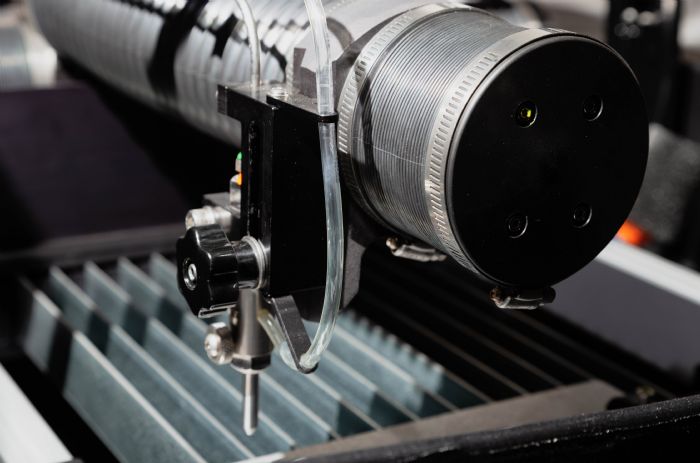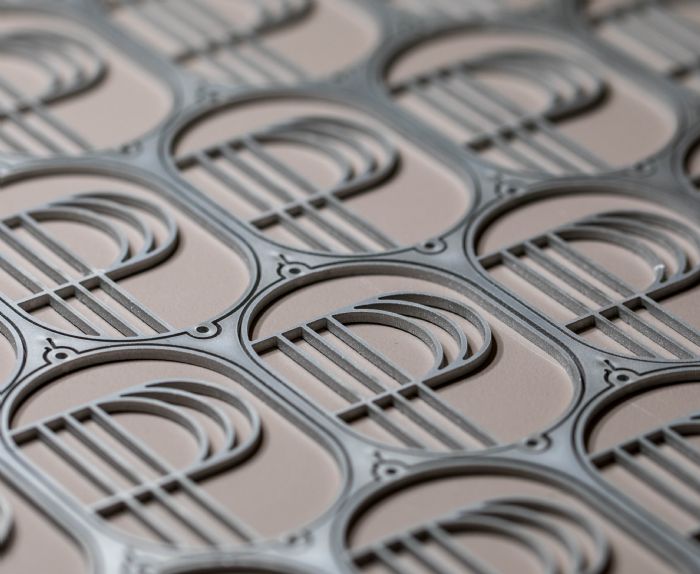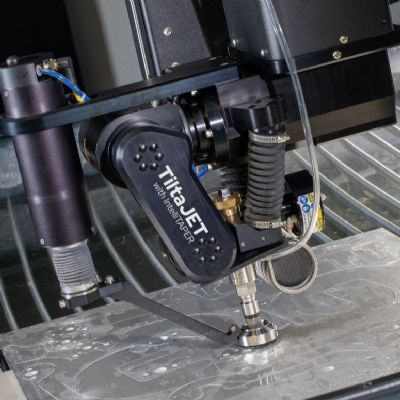Shops may opt to use finer abrasives to help reduce pitting, but doing so will increase taper. And while coarser abrasives may cut more aggressively, they also will accelerate mixing-tube wear and increase the risk of nozzle plugging, unless a correspondingly larger mixing tube is used.
By selecting the correct abrasive and corresponding flow rate, and regularly testing and verifying flow rate, shops can save money and produce better-quality parts.
Slats and Sacrificial Material
 Waterjet users tend to place workpieces repeatedly on one section of the cutting table. For example, they may routinely cut in the bottom left corner of the table because it is nearest to the machine’s controls. As a result, the slats in this area will develop uneven wear over time, which can cause the material to rock on the slats during cutting and reduce precision. To ensure accurate cutting, take care to maintain the slat bed by periodically rotating the removable slats; replace any weakened or worn slats.
Waterjet users tend to place workpieces repeatedly on one section of the cutting table. For example, they may routinely cut in the bottom left corner of the table because it is nearest to the machine’s controls. As a result, the slats in this area will develop uneven wear over time, which can cause the material to rock on the slats during cutting and reduce precision. To ensure accurate cutting, take care to maintain the slat bed by periodically rotating the removable slats; replace any weakened or worn slats.
One common practice is to flip the slats horizontally or vertically, or move them to a different area of the table entirely. Create a schedule to inspect and rotate the slats at least monthly. When replacing a defective slat, inspect the slat holder for excessive wear, and replace worn slat holders.
Experienced waterjet users know when to use sacrificial backing material when cutting parts. Those shops accustomed to cutting aluminum or steel plate 1/4 in. or thicker typically have not had to use sacrificial material. However, when cutting thin, brittle or tubular material, a sacrificial piece may make all the difference in cut quality.
The three main reasons to use sacrificial backing material: stabilize thin materials resting on the slats; reinforce brittle materials; and reduce frosting, where stray abrasive particles can result in a cloudy or rough appearance on the workpiece surface. Be sure to select a sacrificial backing material that is softer than the workpiece material, so that the waterjet pierces without much resistance.
When cutting very thin sheet, the initial piercing of the waterjet may create enough force to cause distortion. In these cases, securing the workpiece to the sacrificial backing will provide additional rigidity while ensuring accurate cuts.
Mixing Tubes
The mixing tube—the part of the nozzle that concentrates and directs the water/abrasive mixture—is directly responsible for meeting the tolerance requirements of precision applications. Over time, the abrasive jet stream may gradually become elliptical, which can cause tool offset to vary by a few thousandths of an inch, depending on the orientation of the stream shape with respect to the tool path. This elliptical shape usually results from uneven wear of the mixing tube, and will increase over time. To help ensure even wear of the mixing tube and maximize its life, rotate the tube by a quarter turn after every 8 hr. of cutting time. Given that a standard mixing tube can cost several hundred dollars, you’ll want to take care of each tube to make it last while still producing parts within spec.
To identify when cutting performance has begun to degrade due to mixing-tube wear, cut test parts and conduct kerf checks on a regular basis. If the tests find that the waterjet is not removing enough material, decrease the tool offset by one-half the dimensional error observed. Likewise, if too much material is being removed, increase the offset by one-half the dimensional error.
Replace the mixing tube when tolerances drop below acceptable levels. To maintain the highest level of precision, change the mixing tube after 45 to 80 hr. of cutting time. MF
Article provided by Omax Corp., Kent, WA: www.omax.com.
View Glossary of Metalforming Terms
See also: Omax Corporation
Technologies: Cutting
Comments
Must be logged in to post a comment. Sign in or Create an Account
There are no comments posted. Cutting
CuttingOmax Launches Mobile Ordering Application
Thursday, June 20, 2024






 As far as cost savings and efficiency goes, there are few skills better to learn then how to manage your abrasive. Operators of waterjet cutting machines should set the rate of garnet flow based on the size of the machine’s nozzle orifice and the mixing-tube diameter. Using excess garnet only wastes money, and the mixing tube will not be able to handle the volume; too little garnet will impact separation speed, resulting in inefficient cutting and adding hours to the job time. Often, the higher the flow rate, the quicker the separation speed. This sounds counter-intuitive,
As far as cost savings and efficiency goes, there are few skills better to learn then how to manage your abrasive. Operators of waterjet cutting machines should set the rate of garnet flow based on the size of the machine’s nozzle orifice and the mixing-tube diameter. Using excess garnet only wastes money, and the mixing tube will not be able to handle the volume; too little garnet will impact separation speed, resulting in inefficient cutting and adding hours to the job time. Often, the higher the flow rate, the quicker the separation speed. This sounds counter-intuitive, 